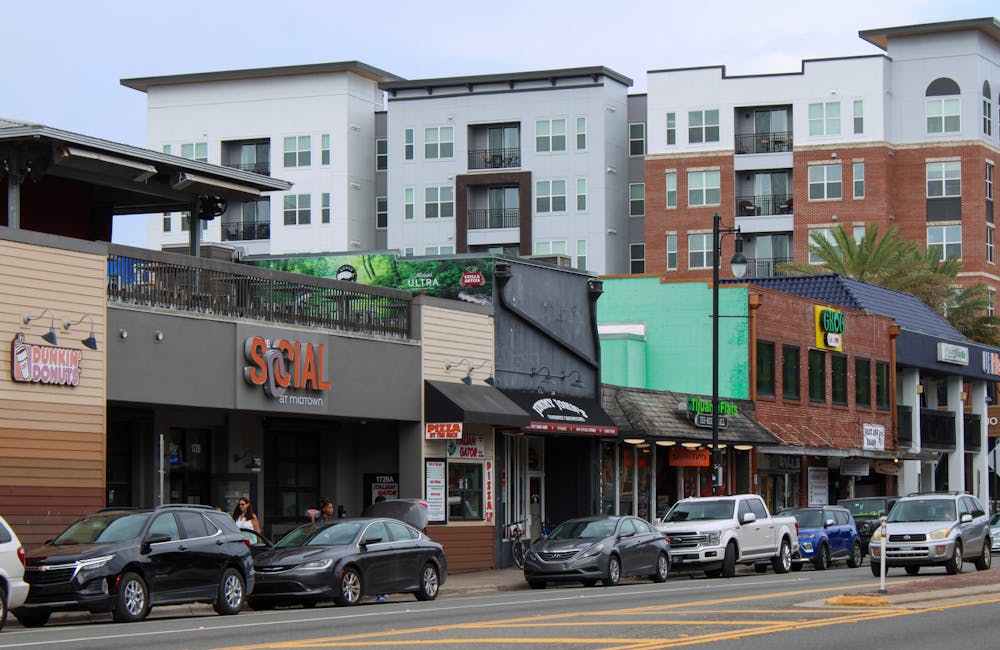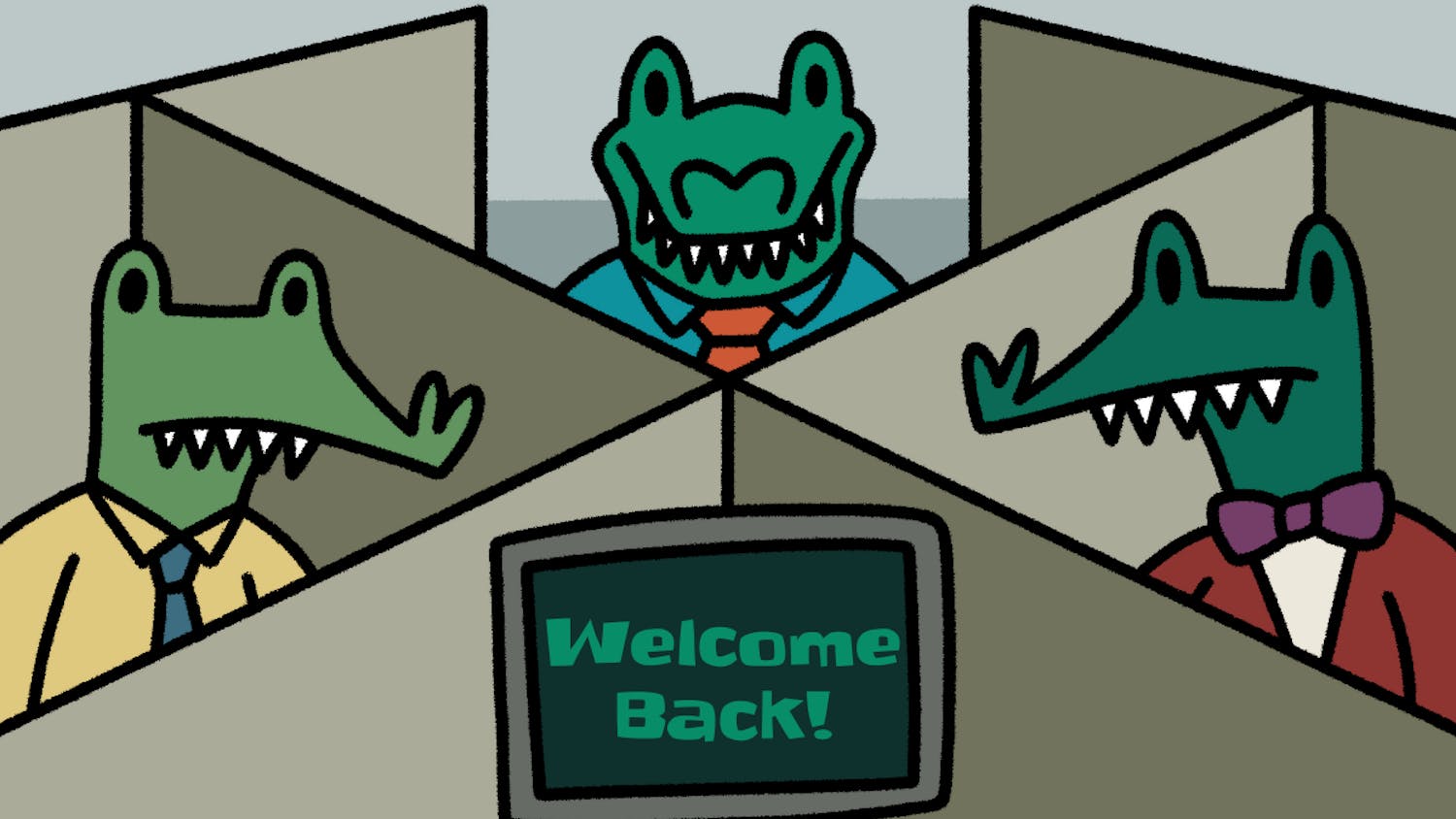The open roads of suburban Pembroke Pines in South Florida proved no match for 20-year-old psychology junior Sydney Olin as she drove from one place to the other in her four-door Toyota Camry.
But a nearly five-hour road trip to her home away from home in Fall 2022 would be the beginning of a new path for her as she learned to navigate the roads of Gainesville.
The first time Olin embarked on the local roads was upon moving into her apartment at the Canopy, located at Southwest 20th Avenue. The entrance to the building rests on a U-turn, which takes drivers a few lights down to make, she said, which poses a point of frustration.
“Here it is a lot different [than South Florida],” she said. “The roads are more twisty-turny…it’s a nightmare.”
Ongoing construction, irregular traffic lights, limited parking spaces and pedestrian pathways along certain roads raise questions of concern for Gainesville residents as they navigate the city. The presence of a public university and relentless residential communities within an approximately 64-square-mile space creates congestion in this college-town reminiscent of that in a big city.
With the help of her brother and friends driving her around the town in the year before she began doing so herself, Olin said she was slightly prepared for what the Gainesville traffic scene would have in store for her. The confines of UF’s campus and bustling nightlife of Midtown always keep her on guard.
“I’m scared I’m going to hit someone every single time I go on campus,” she said. “At night, if people are going out and drinking and running across the roads, it is pretty scary.”
But nonetheless, traffic scares still pose threats to native drivers of Gainesville.
Ayla Babanikos, a 22-year-old UF alumna, has braced the town’s public roads since she was 16. The day she earned her driver’s license, she took a trip downtown by herself for the first time.
The day she accomplished this feat left her with the confidence to take her vehicle anywhere in Gainesville. But the steady evolution of the town’s traffic scene was something she could have never prepared herself for as the population grew too large for Gainesville roads.
Residing in Gainesville all year round, Babanikos can attest to the differences in traffic when the university closes for holiday or seasonal breaks.
“When the students leave,” she said, “it feels like the city kind of takes a breath and relaxes.”
As a developing city adjusting to the influx of students and families moving to it each year, Gainesville seems to have failed to efficiently keep up with the growing population, she said.
“I don’t think that the town is necessarily equipped yet for all of the people in Gainesville,” she said. “It sometimes feels a little too congested in certain areas.”
Babanikos has seen the bulk of construction along University Avenue, specifically, in response to the number of traffic accidents that have occurred there in recent years. These city safety measures, although necessary, she said, have hindered her ability to travel quickly and efficiently amid the area.
“If you wanted to take a five-minute drive down University to get somewhere,” she said. “It took you 20 minutes instead because it was so backed up with all the lane closures.”
But the root of the road problem in Gainesville, for Babanikos, is not so much the roads themselves but the people on them. She finds many new Gainesville drivers’ carelessness and unfamiliarity with the road junctions can pose a dangerous threat to safe travel.
“I see a lot of people on their phones, swerving in and out of lanes,” she said. “The more people learn how to use things like traffic circles or more common sense when they are driving, things would go a lot smoother.”
Ruth L. Steiner is a professor and director of the Center for Health and Built Environment. She has spent three decades pursuing research on city policies and accommodations of transportation. And much of her study has led her to look into the town whereshe works.
“Gainesville is not that different from most cities in the U.S.,” she said. “We’re a typical college town, where we have lots of people working for a single employer.”
Much of the local population is traveling to the same place— UF. As a result, Gainesville is forced with the difficult task of accommodating all modes of transportation, Steiner said. As students have moved closer to campus, the conflict of creating a safe transportation space for both drivers and pedestrians has become larger and larger.
“In some respect, we’ve created an urban environment with all these dense residential locations close to campus,” she said. “But we still have a suburban style of transportation system with infrequent crossing locations.”
For Steiner, students and other pedestrians are put at risk as ill-designed roadways complete University Avenue and 13th Street.
The risk of danger increases farther away from campus, Steiner said, as lanes close in and speed limits rise.
“There is no safe place for me to be,” she said. “Some people call it the dash to death.”
Steiner said the city possesses a first mile/last mile problem, which refers to the lack of regular and important public transit stops where there should be. But, she has noticed the city has tried to reconcile the issue by establishing more crosswalks, which she said are still too long of a distance for most pedestrians.
“In my case, I have to walk 10 blocks to go 100 feet,” she said. “And pedestrians generally are not willing to do that.”
Novice or not, many have faced the challenges Gainesville traffic has presented, whether it be through car, bus, bike or foot. But nonetheless, public works projects are in progress, including ramp, roadway and sidewalk improvements.
Contact Jared Teitel at jteitel@alligator.org. Follow him on Twitter @jaredteitel.
Jared Teitel is a third-year journalism major, and this is his second semester as an Avenue reporter. In his free time, he enjoys running, shopping, and drinking coffee.






